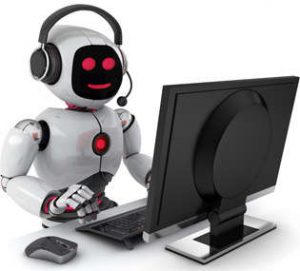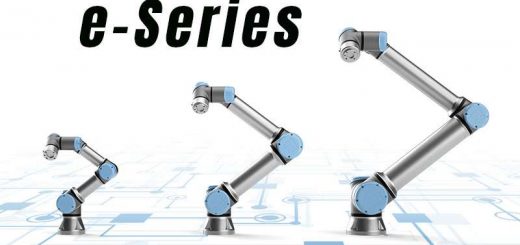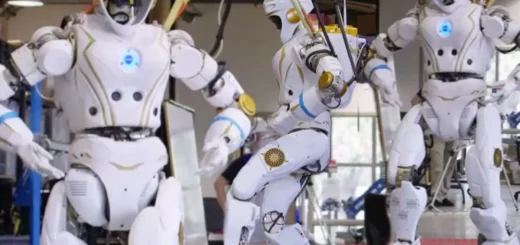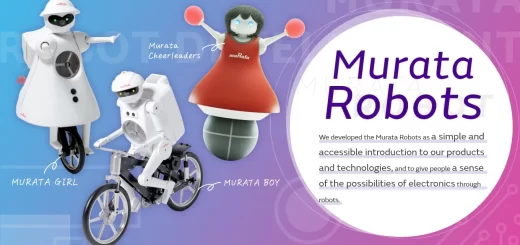Robot software and Best Programming Language for Robotics
The robot software is used to perform autonomous tasks , It is the set of coded commands or instructions that tell the mechanical device & the electronic system , known together as a robot , what tasks to perform , Many software systems & frameworks have been proposed to make programming robots easier .
Industrial robot software
The robot software is able to develop the intelligent mechanical devices , The most common tasks include feedback loops , control , path-finding , data filtering , locating & sharing the data , Although many softwares are about manipulation of the data & seeing the result on screen , The robot software is for the manipulation of the objects or the tools in the real world .
Industrial robot software consists of the data objects & the lists of instructions , known as the program flow ( list of instructions ) , The data & program reside in separate sections of the robot controller memory , You can change the data without changing the program & vice versa , The robot software can create the robotic applications that help or entertain the people , The applications contain command-and-control & tasking software .
You can learn autonomous robot control theory , It helps you to build a simulator that allows you to practice control theory on a simple mobile robot , The robot can guess the state of the real world based on the measurements returned by its sensors , It can change the state of the real world through the application of its control signals , Every robot comes with different capabilities & control concerns .
So , one of the first steps in control design is to come up with an abstraction of the real world , known as a model , with which to interpret the sensor readings & make the decisions , The robot may be an autonomous mobile robot , So , it will move around in space freely & it will be done under its own control , This is in contrast to , an RC robot (which is not autonomous) or a factory robot arm (which is not mobile) .
There are many different ways the robot may be equipped to monitor its environment , These can contain anything from the proximity sensors , the light sensors , the bumpers , the cameras , and so forth , The robots may communicate with the external sensors that give it the information the robot itself cannot directly observe .
Best Programming Language for Robotics
We are investing a lot of time & effort in learning a new programming languages , If you are a new roboticist , you want to learn the programming languages which are going to be useful for your career , many programming languages are used in the world to program micro-controllers , They are far too many to learn , Each language has different advantages for robotics .
The roboticists should develop the Programming Mindset rather than to be proficient in one specific language , it doesn’t really matter which programming language you learn first , Each language develops your proficiency with the programming mindset & makes it easier to learn any new language , Programming your robot is the final step involved in building the robot , When you have chosen the actuators , the electronics , the sensors & more .
C/C++
C/C++ is one of the most popular languages , C presents high-level functionality while keeping a good low-level control , Java is more modern than C and it presents many safety features to the detriment of low-level control .
Many people agree that C & C++ are a good starting point for new roboticists , Because a lot of the hardware libraries use these languages , They allow the interaction with low level hardware , allow for the real time performance and they are very mature programming languages , C/C++ is the Number 1 programming language in the robotics .
As the language has much more functionality , So , You’ll use C++ more than C , C++ is an extension of C , It can be useful to learn at least a little bit of C first , so , you can know it when you find the hardware library written in C , C/C++ are not as simple to use such as Python or MATLAB .
It can take a lot longer to implement the same functionality using C & it will require many more lines of code , Although , as the robotics is very dependent on the real time performance , C and C++ are the closest thing that the roboticists have to be a standard language .
Python
The most important thing is to find the language that feels natural for you and fits with your robotic hardware , You want a language that enables you to develop the programs quickly & easily , so that you can focus more on developing functionality , So , You have to learn Python first .
Python is a superb straightforward language to learn & hugely powerful thanks to the many , easily accessible libraries , You can produce usable code in Python as fast as you can type , After you have gotten reasonably proficient using Python language , You have to learn C , followed by C++ , You will need it to interface with a huge majority of robotic hardware drivers .
Python (and C++) are the two main programming languages found in ROS , such as Java , There is a huge resurgence of Python in the recent years especially in the robotics , it is an interpretive language , the prime focus of the language is ease of use , Unlike Java , Python dispenses with a lot of usual things which take up the time in programming , such as defining & casting variable types .
We can see a lot more Python in the robotics , Python enables simple bindings with C/C++ code , The performance of heavy parts of the code can be implemented in these languages to avoid the performance loss , many electronics support Python out-of-the-box .
Java
Some computer science degrees teach Java to the students as their first programming language , Java hides the underlying memory functionality from the programmer , that makes it easier to program than , say , C , but this means that you have less of an understanding of what it is actually doing with your code .
When you come to the robotics from the computer science background ( and many people do , especially in the research) you will probably have learned Java , Like C# & MATLAB , Java is an interpretive language , that means that it is not compiled into the machine code .
The Java Virtual Machine interprets the instructions at run-time , The theory for using Java is that you can use the same code on many different machines , thanks to the Java Virtual Machine , this doesn’t always work out and can cause the code to run slowly , Although , Java is quite popular in some parts of the robotics , so , you may need it .
C#/.NET
C# is a proprietary programming language offered by Microsoft , C#/.NET is included largely because of the Microsoft Robotics Developer Studio , that uses it as its primary language , If you are going to use this system , you’re going to have to use C# , However , learning C/C++ first might be a good option for long term development of your coding skills , .NET/C# is used to develop the applications in Visual Studio .
MATLAB
There is a very popular Robotics Toolbox for MATLAB , Some people have developed the entire robotics systems using MATLAB alone , If you want to analyze data , produce advanced graphs or implement control systems , you will want to learn MATLAB , MATLAB & its open source relatives such as Octave , is very popular with some robotic engineers for analyzing the data & developing the control systems .
Assembly
Assembly language is one step away from the machine code but it is very tedious to use , Assembly should only be used when you need absolute instruction-level control of your code , Assembly helps you program at the level of ones & zeros , This is a programming at the lowest level (more or less) .
In the recent past , Many low level electronics required programming in Assembly , With the rise of Arduino & the others such the micro-controllers , you can program easily at this level using C/C++ , So , Assembly is going to become less necessary for most roboticists .
BASIC / Pascal
BASIC & Pascal are the basis for many industrial robot languages & they were two of the first programming languages , Basic is one of the first widely used programming languages , it is still used by some micro-controllers ( Basic Micro , BasicX , Parallax ) for the educational robots .
BASIC was designed for the beginners , It stands for Beginners All-Purpose Symbolic Instruction Code , that makes it a pretty simple language to start with , Pascal language introduces the constructs such as the pointers , that makes it a good stepping stone from BASIC to a more involved language & it was designed to encourage good programming practices .
These days , both languages are a bit outdated to be good for everyday use , However , it can be useful to learn them if you are going to do a lot of low level coding or you want to become familiar with the other industrial robot languages .
Nearly every robot manufacturer has developed their own proprietary robot programming language , that has been one of the problems in the industrial robotics , You can become familiar with several of them by learning Pascal , Although , you are still going to have to learn a new language every time you start using a new robot .
LISP
LISP is not as widely used as many of the other programming languages , It is the world’s second oldest programming language ( FORTRAN is older , but only by one year ) , It is still quite important within Artificial Intelligence programming , Parts of ROS are written in LISP , although you don’t need to know it to use ROS .
The programming options such as ROS Industrial have started to offer more standardized options for the programmers , Although , if you are a technician , you are more likely to have to use the manufacturer’s language .
Hardware Description Languages (HDLs)
Hardware Description Languages are used to program Field Programmable Gate Arrays (FPGAs) , So , They are quite familiar to some roboticists , FPGAs allow you to develop the electronic hardware without having to produce the silicon chip , that makes them a quicker & easier option for some developments , These languages are a programming way of describing the electronics .
You may never use HDLs , If you don’t prototype the electronics , so , You should know that they exist , as they are different from the other programming languages , all the operations are carried out in parallel , rather than sequentially as with the processor based languages .
Processing (Arduino) is a variant of C++ which contains some simplifications to make the programming easier , Python is one of the most popular scripting languages , It is very simple to learn and it can be used to put the programs together very fast & efficiently .
Scripting languages
The scripting language is a high-level programming language that is used to control the software application , It is interpreted in real-time or translated on the fly , instead of being compiled in advance , The scripting language is a general purpose programming language or it may be limited to specific functions used to augment running of the application or the system program .
The scripting language has the data objects residing in the registers & the program flow represents the list of instructions or the instruction set that is used to program the robot , The scripting language instruction set is a streamlined list of program commands that are used to simplify the programming process & offer rapid application development .
The programming languages in the industrial robotics are designed for building the data structures & algorithms from scratch , while scripting languages are intended more for connecting or gluing the instructions & components together .
Parallel languages
All robotic applications need parallelism and event-based programming , Parallelism is where the robot does two or more things at the same time , This requires appropriate hardware and software .
Many programming languages depend on the threads or complex abstraction classes to handle parallelism & the complexity that comes with it , like concurrent access to shared the resources , URBI offers a higher level of abstraction by integrating parallelism and the events in the core of the language semantics .
Safety considerations
You can create manageable chunks of functional code , By creating the segments of code specific to each product , you gradually build up the library , Develop the file system on your computer to easily look up the necessary code .
You have to document everything within the code using the comments , Documenting everything is necessary in all jobs , especially the robotics , As you become more & more advanced , you may add the comments to general sections of code , though as you start , you should add the comment to (almost) every line .
You have to save different versions of the code , do not always overwrite the same file , if you find that your 200+ lines of code do not compile , you won’t be stuck going through it line by line , but you can revert to a previously saved (and functional) version & add / modify it as needed , Code does not take up much space on the hard drive , so , you should not feel pressured to only save few copies .
The programming errors give you many dangerous safety consideration in large industrial robots , The power & size of the industrial robots , So , they can inflict severe injury if they are programmed incorrectly or they are used in an unsafe manner .
It is unsafe for the human to remain in the work area of the robot during the automatic operation because of the mass & high-speeds of industrial robots , The system can begin motion at unexpected times & a human will be unable to react quickly enough in many situations , even if prepared to do so .
So , if the software is free of programming errors , great care must be taken to make an industrial robot safe for human workers or human interaction , such as loading or unloading parts , clearing the part jam , or performing maintenance .





Are their robots available now that companies need a software developer to make them use human-like features? I would thoroughly enjoy developing libraries using C# .Net.